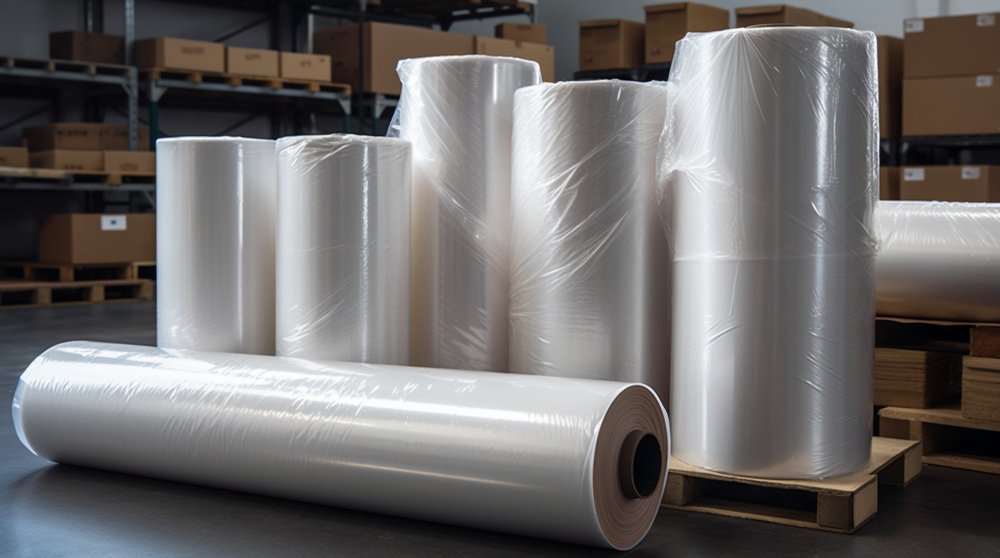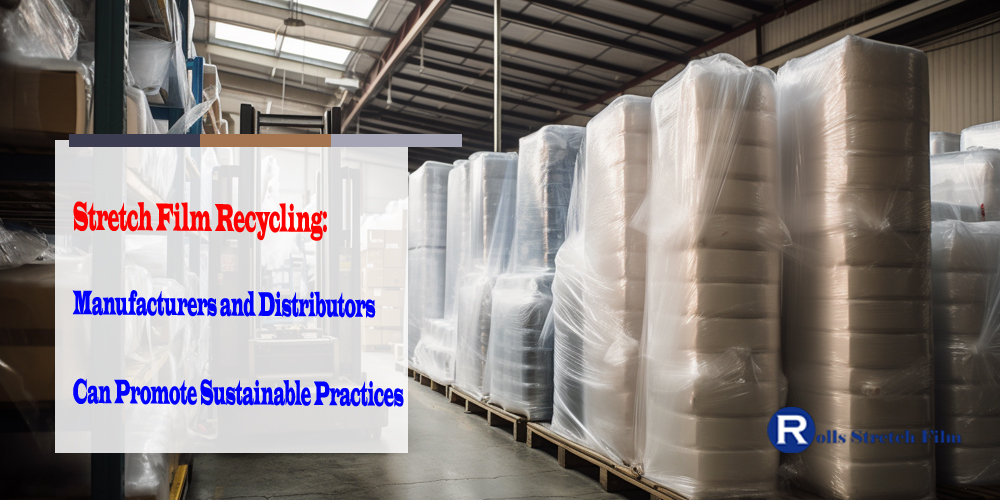The manufacturing and distribution industries produce significant plastic waste due to stretch film usage. However, there is a solution: implementing stretch film recycling methods.
Manufacturers and distributors can promote sustainable practices by implementing stretch film recycling methods. Recycling stretch film diverts waste from landfills, reduces greenhouse gas emissions, and saves on waste disposal costs. Companies can participate in existing recycling programs or partner with a company specializing in stretch film recycling.
Discover best practices for successful implementation and real-life examples of successful stretch film recycling programs.
The Current State of Stretch Film Recycling

Stretch film recycling should be more widely practiced. Many companies in the manufacturing and distribution industries need help to adopt sustainable practices due to challenges such as cost, infrastructure, and lack of awareness. Moreover, it is not uncommon for a stretch film to end up in landfills, which takes hundreds of years to break down.
Challenges Faced by Manufacturers and Distributors When It Comes to Implementing Sustainable Practices:
- Cost of recycling stretch film: One of the biggest challenges manufacturers and distributors face is the cost of recycling stretch film. Recycling programs require a significant financial investment, which can deter companies from pursuing this option. Moreover, there is often a need for more infrastructure to support stretch film recycling. Recycling facilities that can process stretch film are less widespread than those that handle other types of plastic waste. This creates logistical challenges for companies looking to recycle their stretch film.
- Lack of awareness: Another challenge is the need for more awareness among manufacturers and distributors about the importance of sustainable practices. Many companies need to be made aware of the environmental impact of stretch film waste and therefore do not prioritize recycling. In some cases, companies may even view recycling as an inconvenience that slows down their operations.
Benefits of Stretch Film Recycling
Despite the challenges of implementing stretch film recycling practices, significant environmental and financial benefits exist.
Environmental Benefits of Stretch Film Recycling
- Reduces plastic waste in landfills: Stretch film recycling diverts plastic waste from landfills, where decomposing takes hundreds of years. By reducing plastic waste in landfills, we can conserve natural resources and reduce the greenhouse gas emissions associated with plastic production.
- Conserves natural resources: Recycling stretch film reduces the need for new plastic production, which helps to conserve natural resources such as oil and gas. This can help reduce plastic production’s environmental impact, which can be significant.
- Reduces greenhouse gas emissions: The production of plastic is associated with significant greenhouse gas emissions. By recycling stretch film, we can reduce the amount of plastic that needs to be produced, reducing greenhouse gas emissions.
- Saves energy: Producing new plastic requires a significant amount of energy. By recycling stretch film, we can reduce the energy required for plastic production, which helps conserve natural resources and reduce greenhouse gas emissions.
- Promotes a circular economy: Stretch film recycling promotes a circular economy, where materials are reused and recycled rather than discarded. This helps to reduce the amount of waste generated and promotes sustainable practices.
- Reduces litter and pollution: Plastic waste can cause litter and pollution, which can have significant environmental impacts. By recycling stretch film, we can reduce the amount of plastic waste in the environment, which helps prevent litter and pollution.
Financial Benefits for Manufacturers and Distributors Who Adopt Sustainable Practices
- Reduces waste disposal costs: By adopting stretch film recycling practices, manufacturers and distributors can reduce the amount of waste that needs to be disposed of in landfills, resulting in cost savings.
- Increases operational efficiency: Implementing sustainable practices such as stretch film recycling can help streamline operations and reduce waste, improving operational efficiency and saving on costs.
- Attracts and retains customers: Consumers have a growing demand for sustainable products and packaging. By adopting sustainable practices such as stretch film recycling, manufacturers and distributors can appeal to this market and differentiate themselves from competitors, increasing customer loyalty and higher sales.
- Enhances brand reputation: Adopting sustainable practices such as stretch film recycling can enhance a company’s brand reputation, which can positively impact sales and revenue. Customers are more likely to support companies that prioritize sustainability.
- Increases employee engagement: Adopting sustainable practices can improve employee engagement and morale. Employees are more likely to feel proud of their company and work if they know their company is committed to sustainability.
- Reduces regulatory risk: Many governments and regulatory bodies implement regulations and policies to promote sustainability. Manufacturers and distributors can reduce their regulatory risk by adopting sustainable practices such as stretch film recycling and avoid potential penalties or fines.
Methods for Implementing Stretch Film Recycling
There are different methods for implementing stretch film recycling, depending on the needs and resources of individual companies.

- Participate in existing recycling programs: One option is to participate in existing recycling programs. Many cities and states have recycling programs that accept stretch films. Companies can contact their local recycling program to find out how to participate.
- Partnering with a recycling company: Another option is to partner with a recycling company specializing in stretch film recycling. These companies can provide recycling bins and pick up stretch film waste regularly. This option can be more expensive than participating in a recycling program, but it provides more comprehensive support for companies that want to adopt sustainable practices.
Overview of Best Practices for Successful Implementation
Implementing stretch film recycling practices requires a commitment to sustainability and a willingness to invest in the necessary infrastructure. To ensure the success of a stretch film recycling program, companies should follow some best practices:
- Conduct a waste audit: Before implementing a stretch film recycling program, companies should conduct a waste audit to determine the amount of stretch film waste they produce. This can help identify opportunities to reduce waste and the most effective recycling methods.
- Educate employees: Companies should train employees on the importance of stretch film recycling and how to dispose of the material properly. This helps ensure that everyone in the organization is committed to sustainable practices.
- Set goals and track progress: To ensure the program’s success, companies should set specific goals for reducing stretch film waste and track their progress over time. This can help identify areas where improvements can be made and demonstrate the program’s benefits to stakeholders.
- Communicate with stakeholders: Companies should communicate their commitment to sustainable practices to customers, suppliers, and investors. This can help to build support for the program and demonstrate the company’s leadership in promoting sustainability.
Examples of Successful Stretch Film Recycling Programs
- Walmart: Walmart has implemented a stretch film recycling program at its distribution centers. The program has resulted in a significant reduction in waste and cost savings for the company.
- Owens Corning: Owens Corning, a building materials manufacturer, has implemented a comprehensive sustainability program that includes stretch film recycling. The company has set ambitious goals for reducing waste and has implemented various initiatives to achieve those goals, including stretch film recycling.
- Target: Target has partnered with a recycling company to implement a stretch film recycling program. The program has resulted in significant waste reduction and cost savings for the company.
- Tyson Foods: Tyson Foods has implemented a stretch film recycling program at its production facilities. The program has resulted in a significant reduction in waste and cost savings for the company.
- Nestle: Nestle has implemented a stretch film recycling program at its manufacturing facilities. The program has resulted in significant waste reduction and helped the company achieve its sustainability goals.
These companies’ success can be attributed to several factors, including their commitment to sustainability, investment in the necessary infrastructure, and communication with stakeholders. These examples demonstrate that successful stretch film recycling programs are possible and can benefit companies significantly.
The adoption of stretch film recycling practices can have significant benefits for both the environment and businesses. While challenges are associated with implementing these practices, companies can overcome them by committing to sustainability, investing in infrastructure, and educating employees. By doing so, companies can reduce their environmental impact, save on waste disposal costs, and appeal to a growing market of consumers looking for sustainable products and packaging. Therefore, manufacturers and distributors must prioritize sustainable practices and implement stretch film recycling programs.

By adopting stretch film recycling practices, manufacturers and distributors can reduce their environmental impact, save on costs, and appeal to a growing market of consumers who prioritize sustainable products and packaging.














